Macro - Open economy IS-LM
1/58
Earn XP
Description and Tags
Name | Mastery | Learn | Test | Matching | Spaced |
|---|
No study sessions yet.
59 Terms
Openness has three distinct dimensions:
Openness in goods markets
Openness in financial markets
Openness in factor markets
We focus on 1 & 2
Openness in goods markets
Free trade restrictions include tariffs & NTBs
Short term
Openness in financial markets
Capital controls place restrictions on the ownership of foreign assets -can you invest in foreign markets?
Short term
Openness in factor markets
The ability of firms to choose where to locate production (FDI), and workers (migration) to choose where to work
Longer term
Balance of payments
Current account + Capital account + Official reserves
Should the current account and capital account be equal
Yes
but because of data gathering errors they aren’t
Current account
CA = Trade Balance + net investment income + net transfers
Imports and exports of G&S
UK residents receive investment income on their holdings of foreign assets and vice versa.
Countries give and receive foreign aid - the net value is recorded as net transfers received.
The sum of net payments in the current account balance can be positive/negative, in which case the country has a current account surplus/deficit
Capital account
Capital account transactions - Transactions below the line
The capital account balance, also known as net capital flows, can have a surplus/deficit if foreign holdings of UK assets are greater (less) than UK holdings of foreign assets,
Capital account deficit - Negative net capital flow
Capital Account = net decrease in foreign assets
Official Reserves
foreign exchange reserves held by CB
What determines imports
income + exchange rate
o Higher income = higher imports
o Lower real exchange rate = higher imports?
Nominal ER (E)
How much we can swap one currency for another
Why are export ratios high for small countries
The bigger is a country -> the larger is the size of the domestic market -> The more goods and services that it's capable of producing at home.
currency appreciation
Increase in p of domestic currency in terms of foreign currency
Currency depreciation
Decrease in p of domestic currency in terms of foreign currency
Real ER (ε)
ε = EP / P*
P - price of UK goods in £s
P* - price of european goods in €
Real currency appreciation
Increase in relative p of domestic goods in terms of foreign goods
Real currency depreciation
Fall in relative p of domestic goods in terms of foreign goods
exchange rates and inflation
Because inflation rates across countries tend to be relatively similar to each other, the movements in the real and the nominal exchange rate are very similar to each other
In periods where inflation rates differ a lot across countries, then the real and the nominal exchange rate can differ.
Bilateral exchange rates
exchange rates between two countries.
Multilateral exchange rates
exchange rates between several countries.
Multilateral real exchange rate
take all of the bilateral exchange rates between the UK and every other currency in the world + weight those together by the trade shares
foreign exchange
buying or selling foreign currency
What does openness in financial markets allow?
Financial investors to diversify
To hold both domestic and foreign assets and speculate on foreign interest rate movements.
Allows countries to run trade surpluses and deficits
A country that buys more than it sells must pay for the difference by borrowing
Domestic or foreign assets - bonds
When Investing abroad you need to take into account:
E + Interest rate in Foreign + Future E
If both UK and US bonds are to be held then they must have the same expected returns

Interest parity condition / uncovered interst parity (UIP)
the expected rates of return in terms of domestic currency on domestic and foreign bonds must be equal

Why is UIP too strong
The assumption that investors only go for top return is too strong:
• It ignores transaction costs
• It ignores risk – assumes the same risk across both nations
Arbitrage & UIP
Arbitrage implies that the domestic interest rate must be (approximately) equal to the foreign interest rate + the expected depreciation rate of the domestic currency (or minus the expected appreciation).
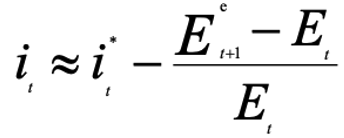
Arbitrage UIP condition with fixed ER

L market assumptions
Fixed p → horizontal AS
ALways unemployed and spare L
Supply side function only has L
Perfect Capital mobility
Goods market in equilibrium
Assume that P and P* are fixed → change in nom = real
Demand for domestic goods: Z = C+I+G-IM/ε + X

Multiplier effect in IS-LM-BP
Y increase → IM increase → NX down → Y down
Multiplier is smaller in an open economy
Some of Y is spent on foreign G/S
How FP (G increase) affects Demand Y graph + NX in open economy
G UP leads to Keynsian cross shifting upwards (Y increases)
BUT trade balance then worsens (gap between X & M widens)
FP now affects trade balance → The increase in output from Y to Y′ leads to a trade deficit equal to BC. Imports go up, and exports do not change.

How foreign Y increases affect domestic Y
Y* increase → NX increase → Y increase
Marshall-Lerner condition
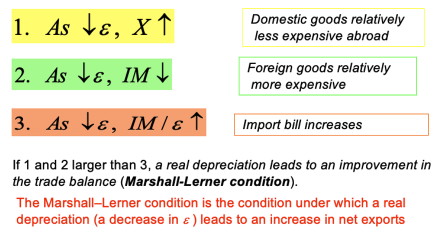
3 dominates in SR but 1&2 dominate overall
Depreciation worsens trade balance initially → trade balance improves over time
J curve effect
When E changes, Importers of signed contracts need to pay more for those imports now (imports have become more expensive)
Once those contracts end, importers find other ways either to source it – e.g. domestically (That causes imports to decline)
For foreign consumers it's made the UK produce goods relatively cheaper (exports rise)
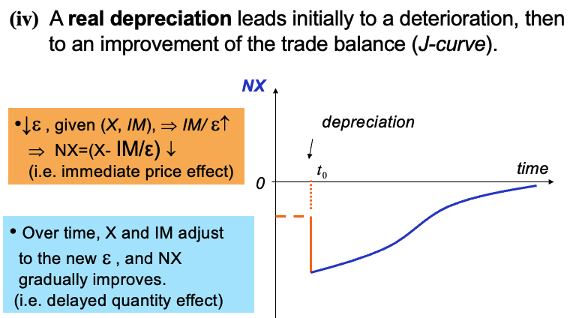
Demand for money in an open economy
M / P = Y * L(i)
M/P - real Ms
the D for money comes from domestic so we can ignore foreigers
Exchange rate & interest rates
Connected through UIP
assume i* and future ER expectations are fixed → Causes upwards sloping relationship

Lowering interest rate abroad encourages people to shift I and so E appreciates as D increased
IS-LM and UIP
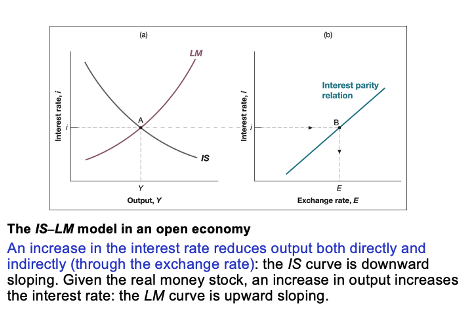
Economy stays at B until shock
Savings, I and trade balance
NX = S + (T-G) - I
Increase in I → one of other variables must rise or NX fall
Increase in Budget defecit → increase in S or fall in I or NX
High savings rate = high I or large trade surplus
FP with floating E
Increase in G → shifts IS outwards → Move along LM → i rises → E appreciates
Income rises → C rises BUT effect on I ambiguos
Income + E rise → IM UP → Reduces import bill effect
NX improves immediately but worsens over time
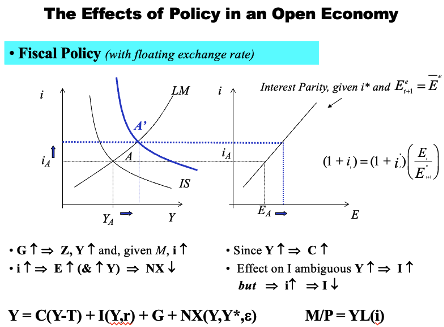
Domestic Fiscal multiplier in open economy

Smaller than in closed
Foreign Fiscal multiplier in open economy

stimulates expansionary effects in domestic
Fiscal multiplier and import propensity
Countries with high import propensities have lower multipliers
If most of the effect of FP goes on foreign goods then the affect of the multiplier is smaller
Expansionary foreign FP graphs (floating E)
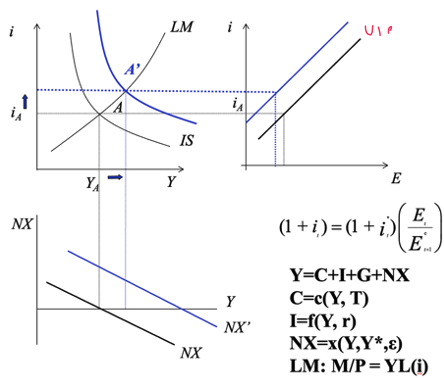
Expansionary foreign FP explained (floating E)
Expansionary FP shifts foreign IS outwards → increases Y* → domestic IS shifts out
E xpansionary FP shifts foreign IS outwards → increases i* → UIP shifts in
E depreciates
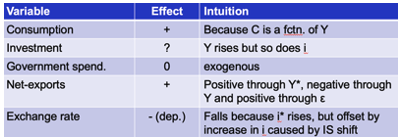
Contractionary MP - floating ER graph
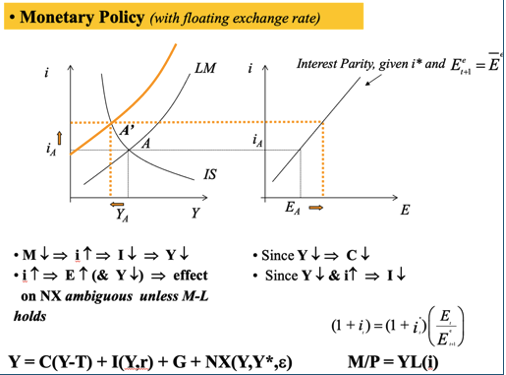
Contractionary MP - floating ER explained
MS has fallen → Return on bonds has to rise to keep equilibrium in money market → i rises → E rises
Y falls → C & IM fall
i rises + reduction in Y -> I decreases
ER appreciates -> X fall & IM rise (as initially cheaper to IM)
Mundell-Fleming model with floating exchange rates
§ An increase in G leads to an increase in Y, an increase in i , and an appreciation.
§ A decrease in Ms leads to an decrease in Y, an increase in i , and an appreciation
Fixed ER and MP
Central banks act under implicit and explicit exchange rate targets, and use MP to achieve those targets
This means it has to give up MP as a tool to fix the economy (macro stabilisation)
Some nations peg to the $
Fixed ER and i
With fixed ER, E wont change over time so the UIP relationship changes
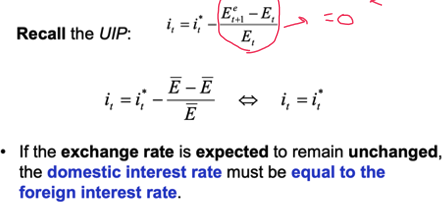
Fixed ER and credability
In order to maintain a peg, the Govt needs credabioity that it will stick to the peg as well as other macro policy
UK had inflation problem in 90s – BofE wasn’t independent so MP lacked credibility as people didn’t think the Govt would stick to target of low inflation / p stability
To gain the credibility the Govt fixed the ER – outspourcing MP to foreign CB
MP and fixed ER
MP becomes endogenous
Ms must adjust to maintain i = i*
If the i differ then the currency will appreciate / depreciate
FP and fixed ER
Effects of FP now magnified → FP moves LM curve
FP triggers accommodating MP
How FP triggers MP with fixed ER
Increase in G → increase in i → capital inflows from foreign rise → market ER appreciates
Fx dealers exploit difference of fixed E and market E - arbitrage
To defend ER, CB sells dom currency → MS rises → i falls → i = i*
Expansionary FP with fixed ER graph
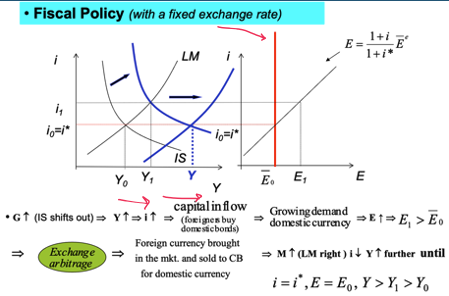
Expansionary FP with fixed ER explanation
IS shifts out → LM auto shifts to keep i at fixed rate → keeps E fixed
Y + C + Ms increase + constant i
Real ER constant - No change in NX from that
Unambiguous worsening of NX from expansionary FP (MS increase but X unchanged)
Contractionary MP with fixed ER - graph
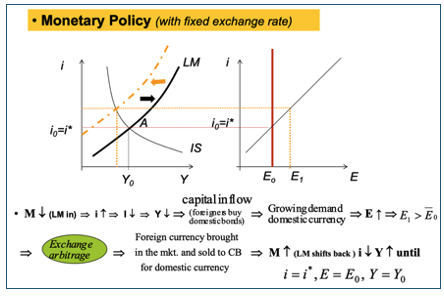
Contractionary MP with fixed ER - explained
LM curve shifts in → move along IS → i rises → I & Y down → capital inflows → E appreciates (E1 > E0)
→ arbitrage (foreign sold to dom CB for dom) → MS increases → LM shits out → i falls → Y rises
Fixed vs Floating overview
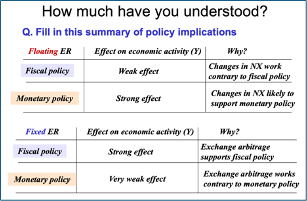
Fixed exchange rate gets back to normal levels at a slower rate than floating